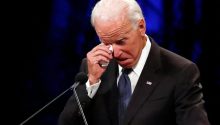by Lorenzo Maria Pacini, Strategic Culture:

Now that the U.S. elections are over and, for the time being, nothing striking has happened, we can draw a sum of Joe Biden’s presidency. And the result is far from positive.
Disaster No. 1: Bidenomics
True, Joe Biden found himself in charge of the U.S. in a not at all delicate phase of the History of the first century of this millennium: the remnants of the Wall Street crisis, the so-called “pandemic” of 2020 with the international blockade, the run-up to the elections with election fraud. Definitely not an easy time, but it has been busy making things worse.
TRUTH LIVES on at https://sgtreport.tv/
Wages have fallen for workers at the same time as prices have risen on almost any product, due to inflation that has risen in the four years of his presidency.
Debt growth over the course of a presidential term, however, does not reflect how much a president has “added to the debt,” since debt accumulation is largely the result of laws that were already in place before a president took office (even early in the term, before there is an opportunity to make changes) and circumstances that are partially or entirely beyond a president’s control. It can be useful to show how politicians have allowed the debt to grow-even due to new policy changes-under each administration. As with the approved debt comparison, the result is affected by many factors, including congressional actions and changes in the economy.
Quickly summarized, federal debt held by the public grew by $5.9 trillion in the first three years and five months of President Trump’s term and by $7.2 trillion over his entire term. The national debt grew by $6 trillion in President Biden’s three years and five months in office. Gross federal debt grew by $6.3 trillion in the first three years and five months of President Trump’s term and by $7.8 trillion during his entire term; gross debt grew by $7.0 trillion during President Biden’s term.
Public debt as a percentage of Gross Domestic Product (GDP) grew by about 23 percentage points under President Trump and remained relatively stable under President Biden, although this disparity is largely driven by the timing of the COVID-19 recession, the subsequent surge in inflation, and their impact on nominal GDP.
The national debt-which is economists’ preferred measure of the national debt because it reflects only the debt the government owes to others and not to itself-has grown significantly: while President Biden has not yet completed his full term, the national debt grew by $3 trillion in his first two years and by $6 trillion in his first three years and five months. Trump left the presidency with a total of $21.6 trillion in debt, which grew to $27.6 trillion under Biden.
The gross national debt, which includes federal debt held by other parts of the federal government, such as the Social Security and federal workers’ trust funds, also grew: +$7 billion over the entire term; it was $27.8 trillion at the beginning of his tenure and now comes out to $34.7 trillion.
At the level of public debt as a percentage of GDP, it should be noted that there was a decline in nominal GDP during the last Trump presidency, while there was an upturn during the Biden period, due to the general recovery.
The economic crisis went hand in hand with the energy crisis. Joe’s “energy war” caused exorbitant price hikes, up to +33.3 percent, with the removal of federally managed oil and gas from the states, costing about 1 million jobs, and imposed the “Heat Your Home” tax just in time for the coming of winter.
But most significant was the attack on the Nord Stream 2 pipeline, connecting Russia and Europe. It was a brilliant move: the U.S. administration first threw the stone and then hid its hand, accusing Russia of self-sabotage, then pulling in the other European countries geographically involved as “possible participants in the sabotage operation,” then letting it all fall back on Ukraine (when by then the evidence was too clear), and finally, upon counter-evidence of the origin of the order from Washington offices, imposed new sanctions on Russia penalizing the U.S. economy in its dealings with Europe further.
Read More @ Strategic-Culture.org



